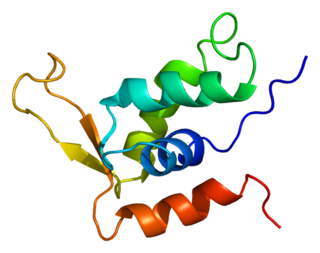
CD14 is a human protein made mostly by macrophages as part of the innate immune system. It helps to detect bacteria in the body by binding lipopolysaccharide (LPS), a pathogen-associated molecular pattern (PAMP).

Vascular cell adhesion protein 1 also known as vascular cell adhesion molecule 1 (VCAM-1) or cluster of differentiation 106 (CD106) is a protein that in humans is encoded by the VCAM1 gene. VCAM-1 functions as a cell adhesion molecule.

Interleukin 16 is a pro-inflammatory pleiotropic cytokine. It's precursor, pro-interleukin-16 is a protein that in humans is encoded by the IL16 gene. This gene was discovered in 1982 at Boston University by Dr. David Center and Dr. William Cruikshank.

Interleukin 20 (IL20) is a protein that is in humans encoded by the IL20 gene which is located in close proximity to the IL-10 gene on the 1q32 chromosome. IL-20 is a part of an IL-20 subfamily which is a part of a larger IL-10 family.

Interleukin 19 (IL-19) is an immunosuppressive protein that belongs to the IL-10 cytokine subfamily.

CSF2RB is a common subunit to the following type I cytokine receptors:

Toll-like receptor 6 is a protein that in humans is encoded by the TLR6 gene. TLR6 is a transmembrane protein, member of toll-like receptor family, which belongs to the pattern recognition receptor (PRR) family. TLR6 acts in a heterodimer form with toll-like receptor 2 (TLR2). Its ligands include multiple diacyl lipopeptides derived from gram-positive bacteria and mycoplasma and several fungal cell wall saccharides. After dimerizing with TLR2, the NF-κB intracellular signalling pathway is activated, leading to a pro-inflammatory cytokine production and activation of innate immune response. TLR6 has also been designated as CD286.

Interleukin 5 receptor, alpha (IL5RA) also known as CD125 is a subunit of the Interleukin-5 receptor. IL5RA also denotes its human gene.

Interleukin-1 receptor accessory protein is a protein that in humans is encoded by the IL1RAP gene.

Forkhead box protein K2 is a protein that in humans is encoded by the FOXK2 gene.

Interleukin-1 receptor-associated kinase 3 is an enzyme that in humans is encoded by the IRAK3 gene. Using in vivo liposome-mediated delivery of CRISPR/Cas9 plasmid expressing IRAK3 gRNA, IRAK3 was shown to be responsible for endotoxin-induced expression of A20 and VE-cadherin in endothelial cells. Thus, IRAK3 is crucial for maintenance and repair of endothelial barrier after endotoxin-induced lung injury.

CD320 is a human gene.

Interleukin-20 receptor beta chain is a protein that in humans is encoded by the IL20RB gene.

Interleukin-2 receptor alpha chain is a protein that in humans is encoded by the IL2RA gene.

TIR domain-containing adapter molecule 2 is a protein that in humans is encoded by the TICAM2 gene.

Interleukin-7 receptor subunit alpha (IL7R-α) also known as CD127 is a protein that in humans is encoded by the IL7R gene.

Ubiquitin-like 7 is a protein in humans that is encoded by the UBL7 gene.

GDNF family receptor alpha like is a protein that in humans is encoded by the GFRAL gene.

Mitochondrial ribosomal protein S2 (MRPS2), otherwise known as uS2m, is a protein that in humans is encoded by the MRPS2 gene.

Mitochondrial ribosomal protein S9 (MRPS9), otherwise known as uS9m, is a protein that in humans is encoded by the MRPS9 gene.























